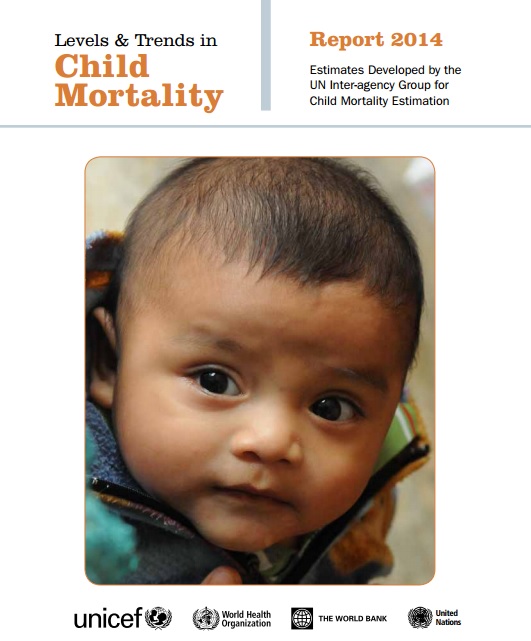New data show child mortality rates falling faster than ever
 New data released by the United Nations show that under-five mortality rates have dropped by 49% between 1990 and 2013. The average annual reduction has accelerated – in some countries it has even tripled – but overall progress is still short of meeting the global target of a two-thirds decrease in under-five mortality by 2015. New estimates in "Levels and Trends in Child Mortality 2014" show that in 2013, 6.3 million children under five died from mostly preventable causes, around 200 000 fewer than in 2012, but still equal to nearly 17 000 child deaths each day.
New data released by the United Nations show that under-five mortality rates have dropped by 49% between 1990 and 2013. The average annual reduction has accelerated – in some countries it has even tripled – but overall progress is still short of meeting the global target of a two-thirds decrease in under-five mortality by 2015. New estimates in "Levels and Trends in Child Mortality 2014" show that in 2013, 6.3 million children under five died from mostly preventable causes, around 200 000 fewer than in 2012, but still equal to nearly 17 000 child deaths each day.
“There has been dramatic and accelerating progress in reducing mortality among children, and the data prove that success is possible even for poorly resourced countries,” said Mickey Chopra, head UNICEF’s of global health programmes. “There is now a gathering momentum from countries in every part of the world to make sure proven, cost-effective interventions are applied where they will save the most lives.”
In 2013, 2.8 million babies died within the first month of life, which represents about 44% of all under-five deaths. About two-thirds of these deaths occurred in just 10 countries. While the number of neo-natal deaths have declined, progress has been slower than for the overall under-five mortality rate.
In June this year, WHO, UNICEF and partners issued the first-ever global plan to end preventable newborn deaths and stillbirths by 2035. The Every Newborn Action Plan calls for all countries to take steps to provide basic, cost-effective health services – in particular around the time of childbirth, as well as for small and sick babies – and to improve the quality of care.
“The global community is poised to end preventable maternal, newborn and child deaths within a generation,” said Dr Flavia Bustreo, Assistant Director General at WHO. “We know what to do and we know how to do it. The challenge now is to move from plan to action – we are pleased to see countries like India beginning to lead the way.”
Among the report’s other major findings:
- Eight of the 60 countries identified as ‘high mortality countries’ – with at least 40 under-five deaths for every 1000 live births – have already reached or surpassed the MDG target (67% reduction). The countries are Malawi (72%), Bangladesh (71%), Liberia (71%), Tanzania (69%), Ethiopia (69%), Timor-Leste (68%), Niger (68%) and Eritrea (67%).
- Eastern Asia, Latin America and the Caribbean and Northern Africa, have already reduced the under-five mortality rate by more than two-thirds since 1990.
- Two countries, India (21%) and Nigeria (13%), together account for more than one-third of deaths among children below 5 years of age.
- While Sub-Saharan Africa has cut under-five mortality rates by 48% since 1990, it still has the world’s highest rate – 92 deaths per 1000 live births – nearly 15 times the average in high-income countries.
- Children born in Angola, which has the highest under-five mortality rate in the world (167 deaths per 1000 live births), are 84 times more likely to die before the age of five than children born in Luxembourg, with the lowest rate (2). Within countries, relative wealth, education, and location are key – a child’s risk of dying increases if she or he is born in a remote rural area, into a poor household or to a mother with no education.
The leading causes of under-five deaths are pre-term birth complications (17%); pneumonia (15%); complications during labour and delivery (11%); diarrhoea (9%); and malaria (7%). Under-nutrition contributes to nearly half of all under-five deaths.
“For continued progress, it is essential to invest more in health systems that deliver high-quality, affordable services to all women and children who need them,” said Olusoji Adeyi, Director of Health, Nutrition and Population at the World Bank Group.
The report notes that major improvements in child survival are in part due to affordable, evidence-based interventions against the leading infectious diseases, such as immunization, insecticide-treated mosquito nets, rehydration treatment for diarrhoea, nutritional supplements and therapeutic foods. The major causes of neonatal mortality – pre-term birth complications (35%) or problems during delivery or birth (24%) – require health interventions closely linked with protecting maternal health.
The Levels and Trends in Child Mortality 2014 report is developed annually by the United Nations Inter-Agency Group for Child Mortality Estimation, which is led by UNICEF and includes the World Health Organization, the World Bank Group and the United Nations Population Division of the Department of Economic and Social Affairs.
Note to editors:
Global estimates of child mortality are challenging to produce because many countries lack complete systems to track vital records. The estimates released today are largely based on statistical models and data from a variety of sources, including household surveys and censuses. All the numbers cited here fall within a statistical confidence range. For example, the estimated global number of 6.3 million deaths in 2013 falls within the statistical confidence range of 6.1 to 6.7.
About UN Inter-agency Group for Child Mortality Estimation (IGME)
The Inter-Agency Group for Child Mortality Estimation or IGME was formed in 2004 to share data on child mortality, harmonise estimates within the UN system, improve methods for child mortality estimation report on progress towards the Millennium Development Goals and enhance country capacity to produce timely and properly assessed estimates of child mortality. IGME is led by UNICEF and includes the World Health Organization, the World Bank Group and the United Nations Population Division of the Department of Economic and Social Affairs.



